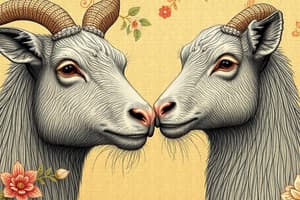Podcast
Questions and Answers
What is the relationship between inbreeding and homozygosity?
What is the relationship between inbreeding and homozygosity?
- Inbreeding leads to an increase in heterozygosity.
- Inbreeding leads to a decrease in homozygosity. (correct)
- Inbreeding has no effect on homozygosity.
- Inbreeding leads to an increase in heterozygosity.
What is hybrid vigor?
What is hybrid vigor?
- An increase in homozygosity.
- A decrease in vigor.
- An increase in heterozygosity. (correct)
- A decrease in heterozygosity.
What is the purpose of inbreeding?
What is the purpose of inbreeding?
- To eliminate valuable traits.
- To decrease homozygosity.
- To obtain homozygous individuals for pure lines and hybridization. (correct)
- To increase heterozygosity.
What is inbreeding depression?
What is inbreeding depression?
What can inbreeding result in?
What can inbreeding result in?
What is the degree of inbreeding?
What is the degree of inbreeding?
How does heterozygosity change with successive generations of inbreeding?
How does heterozygosity change with successive generations of inbreeding?
What is the preferred method for seed production?
What is the preferred method for seed production?
How is the combinative capacity of inbred lines determined?
How is the combinative capacity of inbred lines determined?
What is specific combining capacity?
What is specific combining capacity?
Flashcards are hidden until you start studying
Study Notes
- Inbreeding leads to an increase in homozygosity and a decrease in vigor.
- Hybrid vigor, or heterosis, is related to an increase in heterozygosity.
- Inbreeding is used to obtain homozygous individuals for pure lines and hybridization.
- Inbreeding depression is a reduction in vigor due to increased homozygosity.
- Inbreeding can result in homozygous recessive or dominant genotypes with valuable traits.
- Homozygous recessive forms can be easily recognized and eliminated.
- The degree of inbreeding is the proportion of homozygotes in consanguineous groups.
- Heterozygosity is reduced through successive generations of inbreeding until all genotypes become homozygous.
- The genotypic proportions change with each generation of inbreeding.
- Inbreeding can occur in plants with separate sexes when partners are related.
- Inbreeding leads to homozygosity and decreased genetic variability.
- Heterosis is achieved by crossing genetically different, inbred lines.
- Obtaining inbred lines involves choosing biological material, obtaining the lines, testing their combinative capacity, and producing F1 hybrids.
- Inbreeding involves self-fertilization for multiple generations.
- Self-incompatibility can make obtaining inbred lines difficult in some species.
- Once obtained, inbred lines can be crossed to find the best combinations for heterosis in the F1 generation.
- Combinative capacity of inbred lines is determined through dialel or cyclic hybridization with a common tester.
- Specific combining capacity is determined to identify the most valuable components for commercial hybrids.
- Double hybrids are preferred for safer and cheaper seed production.
- Production of double hybrids can be specified based on the production of simple hybrids.
Studying That Suits You
Use AI to generate personalized quizzes and flashcards to suit your learning preferences.




